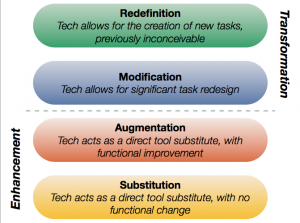Seven years and counting in education. How many of you still use PowerPoint as the main ‘technology’ in your classroom? On occasion, I still use PowerPoint as it is a functional and clean cut presenting software. But with advances in technology, it is now not the only one out there. There are so many options in bringing information to our students in a more creative and meaningful way. As an action plan this year, I want to investigate and challenge myself to take digital tools to a new level within my science classroom. To start, some of you might be asking what the #$%@ is the SAMR model, so I will fill you in with a little background information.
The following diagram describes SAMR when applying it to technology in the classroom.
Our goal is to take previous assessments and move them through the SAMR model to transform them to meet our 21st century learners. I think it’s important to point out that you are not going to always need to push things to the top of the system. Some things are good with simple substitution (using PREZI instead of PowerPoint) or Augmentation (Use of collaboration with GoogleDocs or Padlet). However, I do see the importance of bringing some meaningful assessments (Summative in nature) to the higher level of transformation with a redefinition of task.
An example of application of the SAMR model to an English class and Math class by Michael Hornback with the Vancouver Public Schools. He takes tasks that we have commonly asked our students to perform and brings in technology to create deeper thought through the inclusion of creativity, in order to transform a once simpler method of representing learning. In his examples, he uses Apps and digital technology accessible through apple products. Similar online tools and apps can be found for PC’s as well.
How might this be implemented in the science class? Well, for years, the ministry has pushed inquiry based labs within the science classroom. However, they never truly trained or gave even reasonably good examples for teachers to follow. My thought is to take a once cookie cutter lab and use the SAMR model along with new technologies for scientific modelling to scaffold students to make predictions for application to real or virtual inquiry labs.
A quick conversation with Sir Ken Robinson regarding technology in education: Why it’s important to transform education through technology.
[youtube]http://www.youtube.com/watch?v=UYk91jzv1jg[/youtube]
I’d love to hear some suggestions from you experienced science folk or SAMRs out there.


Tim, I really am excited about this idea. I was having a meeting with the English teachers at my school and we were discussing the SAMR model; it actually was noted a few times that authentic and meaningful “redefinition” tasks were hard to dream up at time…I think because we (like Ken Robinson pointed out) are still learning this technology ourselves!
Just offering suggestions (like the Prezi did) of how each task could look (and you are right, I think there is tremendous value in each…everything doesn’t have to be redesigned) for teachers at your school of what assessments could be is a wonderful offering to your fellow teachers at home and afar!
I totally agree. Someone posted an article about SAMR to our Diigo the other day. The analogy of treating SAMR as a swimming pool where the S and A are considered the shallow end, and the M and R is the deep end. Most of us spend time between the all of them. Certainly redefinition is great but we must explore all of the model, it’s not meant for everything to be redefined but rather a mixture of the lot.
That’s an interesting clip you included, Tim. I especially liked Sir Ken’s comment on how technology – and SAMR in particular – has the potential to change how we think of disciplines. Will we still be looking at the same sort of subjects (ie: English, Math, Science, Phys. Ed, Languages, Social Studies, etc.) ten or twenty years down the road? Will improvements in tech such as autocorrection, spell-checking, and speech-to-text software make some areas of English class obsolete, or will they change the subject altogether?
What slightly worries me about the SAMR model is that students will replace skills that may seem old and less important with new more tech-savvy skills. For instance, will they become great texters and multi-taskers but horrible at face-to-face communication and being patient? Tech-related attitudes concern me as well. If we give kids too much control over their assignments (especially in terms of presentation format), will they ever learn how to do jobs they may not like but have to do? I’d be interested in hearing what concerns you may have and how you deal with them.
Sandy, this is a real concern. The changes that I make in my own class are not always technology focused. In working with SAMR, I plan to include basic skills that may otherwise easily be forgotten. There was an article (http://hookedoninnovation.com/2013/12/10/taking-a-dip-in-the-samr-swimming-pool/) comparing SAMR to a swimming pool. Teachers must not get stuck on Redefinition as the goal; rather focus in all areas of SAMR to explore new technologies without changing the entire game. We must play in both the deep end and the shallow. ‘Old’ technologies are still important in the real world and they should be taught or expected in our classrooms as well. Thanks for the comment, it definitely made me reflect on my action plan a bit more.
Yeah!! Tim, great idea here. I have been mulling over what I could bring to the table and my action plan is due today! It seems you latched onto something that could help in the short term and expand where you take things in the long term too. See you on MARS!
Thanks Brad. I am looking forward to MaRS and seeing where technology is going. It’s really interesting using the classroom as a lab (I think this is something Jen Bibby (http://cohort21.com/members/jenbibby/) mentioned in our first Cohort 21 face to face meeting). It really pushes you to make instructional/pedagogical changes to what you do or expect in your classes. Feedback from my colleagues and students will need to take place to ensure that what I am doing is valuable for them and their learning. See you Friday!
Hi Tim,
The pool analogy for SAMR is particularly helpful, thank you! I wade around in there as well, sometimes rather on the shallow end, but working towards innovation and redefinition like all of us.
I think we should celebrate the fact that we have the freedom to test, learn and grow in SAMR model. You mention your two highly motivated gr12 guinea pigs, brilliant, what a great way for you to wet your feet with whatever you dream up and make progress! Sadly many teachers will not have this opportunity. Interference can come so swiftly and easily from various stakeholders in education. I’ve spoken to some teachers in the public system who are not even permitted to use moderated blogs!
Also liked your point about old technologies still being important.. Not a math teacher on my end but I took the ABQ, and I do recall a conversation about the over reliance of students on calculators, and how so few kids could do things such as long division by hand. Redefinition may be the purported goal of SAMR but one should not get carried away and redefine at the expense of important non-technological skills!
I know, the differences between the public and private institutions are quite astounding. I was a public school teacher for years and there certainly were some stiff guidelines in certain cases. However, only access to technology really played any part in my classroom.
As for SAMR, It’s all about balance. I am beginning to see it even more as we move through this ThingLink assignment. The students do need some cognitive time to figure out the program but also to understand your expectations. I was also amazed, yet not surprised, to hear a student say, ‘All the rubrics are the same’. I said, ‘That may be in some classes but we design these rubrics with you and this assignment in mind, read it and you will do better.’ Another blog in the making perhaps. Thanks for your comment Louis!